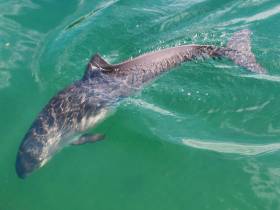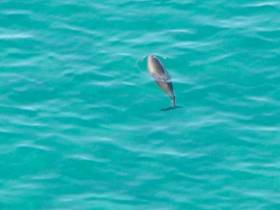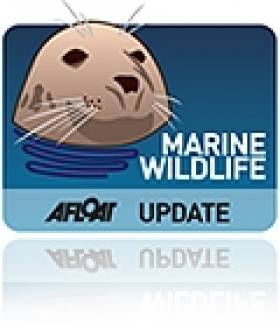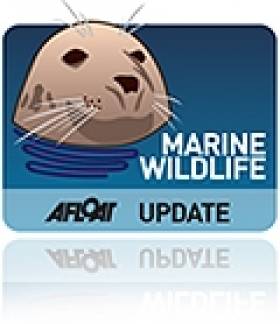Displaying items by tag: Porpoises
Data Buoys To Monitor Marine Wildlife During Dublin Port Dredging
#MarineWildlife - This weekend Dublin Port is deploying data buoys in Dublin Bay to monitor marine wildlife activity during the controversial dredging works at Alexandra Basin.
According to The Irish Times, the four boys will provide live data on any whales, dolphins or porpoises in the vicinity of the Burford Bank near Howth, where up to a million tonnes of dredge spoil will be dumped over the next few weeks.
As previously reported on Afloat.ie, campaigners have raised concerns about the safety of Dublin Bay’s harbour porpoises, protected by an SAC since 2013, during the dredging operation.
The Irish Times has more on the story HERE.
Fears for Porpoises in Dublin Bay As Work Begins to Dredge Port of 1 Million Tonnes of Material
#marinewildlife - Concerns have been voiced by campaigners about the safety of the Dublin Bay porpoise as Dublin Port commences dredging.
The Journai.ie writes that the Dublin Port Company (DPC) plan to remove up to a million tonnes of material from the port and dump it near Howth in order to keep the port deep enough for large naval vessels.
DPC says that the maintenance dredging process, which starts today, will last for between two to four weeks. Maintenance dredging is the periodic removal of sediments and is vital for many ports.
However, campaigners say that the waste material should not be dumped at DPC’s usual site near Howth. They are also fearful that porpoises could be harmed by the dredging vessel.
For more on the story click here.
Afloat adds that a dredger from the UK is to arrive to the port tomorrow.
#MarineWildlife - Dolphin and porpoise monitoring off the North Coast got a boost this week thanks to a £15,000 NI government grant for the Irish Whale and Dolphin Group (IWDG), as Causeway Coastal Community reports.
“This is good news for the IWDG and for those with a passion for marine wildlife," said Northern Ireland's Environment Minister Mark Durkan on funding for the acoustic monitoring project, which will focus on cetacean populations off Portrush and the nearby Giant's Causeway.
The project also includes an outreach programme with local schools and communities to get local people invested in the protection of marine wildlife on their shores. Causeway Coastal Community has more on the story HERE.
Minister Durkan is also the subject of calls to add the waters off Islandmagee to recently recommended Marine Conservation Zones for Northern Ireland over fears that a new gas power station could create a marine 'dead zone' in the area.
Porpoises Hunt By 'Sound Searchlight' Say Researchers
#MarineWildlife - How do whales, dolphins and porpoises hunt for fish? By using 'sound searchlights', according to Danish marine researchers.
As BBC News reports, the team of marine scientists at Aarhus University used underwater microphones to study the hunting behaviour of porpoises.
And they sound that the nimble cetaceans were able to adjust their echolocation abilities – using clicks and buzzes to navigate their surroundings – by switching from a narrow focus to a wide beam of sound as they closed in on their prey.
Scientists believe that other species of dolphins and whales also share this "exceptional" ability – which could provide the key to solutions that would prevent them getting trapped in commercial fishing gear.
BBC News has more on the story HERE.
Porpoises' Biggest Threat? It's Grey Seals, Say European Researchers
#MarineWildlife - Marine scientists think they've found the answer to the mystery of dead porpoises washed up on French and Belgian beaches with dog-like bite marks.
As the Irish Examiner reports, their research points the finger at grey seals - forced into competition with the cetaceans over the fish that make up their diets.
Indeed, it may be overfishing by humans that's prompted the seals to turn on their fellow marine mammals as commercial fishing stocks dwindle in the North Sea.
The Irish Examiner has more on the story HERE.
Six New Marine Sites Chosen for Conservation
#MarineWildlife - Minister for Arts, Heritage and the Gaeltacht Jimmy Deenihan announced on Wednesday the proposal of six new marine sites for designation as Special Areas of Conservation (SACs) to protect marine habitats and species listed on the 1992 EU Habitats Directive.
The six sites around the Irish coast represent habitats (sandbanks and reefs) and/or marine wildlife (specifically dolphins and porpoises) identified as insufficiently represented in the list of Irish SACs at the EU Commission's Marine Atlantic Biogeographic Seminar in 2009. These sites are:
- Blackwater Bank, Co Wexford (Sandbank)
- West Connacht Coast (Bottlenose dolphin)
- Hempton’s Turbot Bank, Co Donegal (Sandbank)
- Rockabill to Dalkey Island, Co Dublin (Reefs and harbour porpoise)
- Porcupine Bank Canyon, off Kerry (Reefs)
- South-East Rockall Bank (Reefs)
The designation of marine SACs is scheduled for completion in Europe in 2012, and according to the minister, this list of six additional SACs will constitute Ireland’s contribution to that process.
In a statement, the department said: "These six SAC sites will protect a range of habitats and species including sandbanks, deep sea coral reefs, dolphins off the Atlantic coast and harbour porpoises found in Dublin Bay.
"These sites are part of a European network of nature conservation sites known as Natura 2000 which was established with the aim of preserving our rich natural heritage for future generations."
Among the new designations are two offshore sites at the Porcupine Bank Canyon and the South East Rockall Bank "contain excellent examples of offshore fauna associated with geogenic reef (ie reef made of rock). Considering the extent of Ireland’s offshore maritime area alongside the value and vulnerability of deep sea biodiversity therein, these two sites represent a modest but highly significant contribution to the Irish SAC network."
Two new inshore areas are being proposed in the west of Ireland to protect the bottlenose dolphin. The department is currently co-funding a multi-annual research programme to further understand the ecology of this species in this coastal region.
Meanwhile, the inshore site off Dublin from Rockabill to Dalkey Island is also being proposed both for the harbour porpoise, and for geogenic reef to address a gap in the SAC network for this habitat type in the northern part of the Irish Sea.
As previously reported on Afloat.ie, the oil exploration company behind the Dalkey Island Prospect has spoken out over the Rockabill to Dalkey Island designation, claiming it had not been given advance information of the decision.
Providence Resources says maps provided by the department appear to show and overlap between the location for a seismic survey and the new SAC area, which would make any development for resource extraction "extremely problematic".
Last week the Irish Whale and Dolphin Group (IWDG) expressed concern over the potential impact of the 2D seismic survey at Dalkey Island on harbour porpoises in Dublin Bay.
Irish Sea 'Teeming' with Dolphins Says Wildlife Charity
#MARINE WILDLIFE - Large numbers of dolphins have been filmed in the Irish Sea off the Welsh coast by wildlife volunteers, as WalesOnline reports.
The conservationists with the Sea Trust charity, based in Pembrokeshire, recorded the "dolphin-fest" from the deck of the Stena Europe ferry en route from Fishguard to Rosslare.
Sea Trust director Cliff Benson confirmed the sighting of "a pod of eight Risso's dolphins, 40-plus common dolphins [and] four porpoises" among others as soon as the ferry headed west of Tusker Rock.
Altogether in the three-hour passage across the Irish Sea, the volunteer surveyors recorded a total of 99 common dolphins, 10 Risso's dolphins and 26 harbour porpoises. "That's not bad for a winter trip," said Benson.
He added that while there are threats to the Irish Sea's cetaceans from scallop dredging and the like, "to date our surveys show this area is teeming with life.
“This is Wales and Ireland we are talking about not Bermuda so get this amount of dolphin and porpoise activity with whales thrown in as well is incredible."
Stena has welcomed Sea Trust volunteers on board its vessels since 2004 to check on cetaceans and other marine wildlife in the waters between Ireland and the UK on a monthly basis.
And as reported previously on Afloat.ie, Seatruck Ferries has also been providing free passage to UK marine wildlife researchers to discover how many dolphins and seabirds make their home in the Irish Sea.
Meanwhile, BBC News reports that a pod of more than 100 bottlenose dolphins was recently spotted off the Isle of Man.
The Manx Whale and Dolphin Watch said it received a number of sightings from the east and west coasts of the island in the northern half of the Irish Sea, reporting a hive of activity.
"The group sizes tend to be relatively ginormous," said Tom Felce of the group. "So if they are here you can't miss them."
Dolphin Group Comments on Dalkey Island Prospect
#DALKEY ISLAND PROSPECT - The Irish Whale and Dolphin Group (IWDG) has joined the chorus of opposition to the proposed oil and gas exploration off Dalkey Island in Co Dublin.
As previously reported on Afloat.ie, Providence Resources has applied for a foreshore licence to search for oil or gas about 6km out to sea on the Kish Bank Basin.
But the prospect has provoked a split in the local community over the potential risks and benefits, with many calling for a public enquiry into the licence before it is granted.
This evening an urgent meeting in Dun Laoghaire will address the public's concerns, which have been echoed by the IWDG.
"The Kish Bank and adjacent waters are important for cetaceans," said the group in a statement. "In addition, sightings of bottlenose dolphins have increased dramatically in the area following the presence of a group of three individuals since August 2010."
The IWDG is concerned about the potential effects on dolphins and porpoises that "could due to noise generated from the drilling process", noting that "there is little published data on the intensity and effects of sound generated by drilling".
Protest group Protect Our Coast has launched a online petition against the Dalkey Island Prospect citing concerns over the proximity of the drilling area to the mainland as well as the Special Protection Area of Dalkey Island, which is a haven for marine wildlife.
- Irish Whale and Dolphin Group
- IWDG
- Dalkey Island Prospect
- Coastal Notes
- Dalkey Island
- Dublin
- oil and gas
- exploration
- drilling
- Providence Resources
- foreshore licence
- Kish Bank Basin
- community
- Dun Laoghaire
- bottlenose dolphins
- Porpoises
- Cetaceans
- noise
- sound
- Protect Our Coast
- protest
- petition
- Special Protection Area
- marine wildlife
Fin Whale 'Feeding Frenzy' Off Hook Head
#MARINE WILDLIFE - A "feeding frenzy" involving a pod of fin whales was spotted off Hook Head in Co Wexford last week, The Irish Times reports.
And according to Andrew Malcolm of the Irish Whale and Dolphin Group (IWDG), two of the whales were in the same location almost exactly a year ago.
Malcolm, who was with a group on board the Rebecca C, used photographs of the whale's dorsal fins to compare records for the confirmation.
The pod of six fin whales was seen feeding some 3km southeast of Hook Head, attracted by the herring spawning grounds in the area.
More than 30 other cetaceans, including common dolphins, porpoises and a minke whale, were sighted on the trip.
The Irish Times has more on the story HERE.
Ferry Operator Assists in Marine-Life Conservation Role
Fastnet Line which runs the Cork-Swansea port route on the Celtic Sea, is assisting the charity MarineLife to monitor cetaceans, writes Jehan Ashmore.
The work of MarineLife is to survey the population trends and track the movements of dolphins, whales, porpoises and other wildlife. The research is undertaken onboard Fastnet Line's Julia (1981/21,699grt) and access to the ferry is provided free-of-charge to the wildlife-based charity.
During the months of July and August the ferry's schedule will allow for further opportunities to conduct daylight sightings of marine-life which is to be posted on MarineLife and Fastnet Line websites.
Adrian Shephard, Chairman of MarineLife Trustees, said: "The route from Swansea to Cork crosses a range of marine habitats and we hope it will generate many sightings of cetaceans and seabirds, including two important species we monitor, the white-beaked dolphin and the balearic shearwater".
In addition monitors recently observed fin whales, the second largest whale on the planet. Such sightings provide vital information and this will contribute to a better understanding of the distribution of cetaceans and other marine life in the Celtic Sea. To read more www.marine-life.org.uk
The first of four summertime surveys is to take place on 10 July. Overall the research by MarineLife is part of a larger project which also involves the use of other ferries operating in the Irish Sea and those serving on UK continental routes.
The 1,500 passenger / 325 car-carrying Julia sails year-round six times a week between September to June and from next month and during August the vessel will provide eight sailings per week. For fares and sailings schedules contact www.fastnetline.com






































































